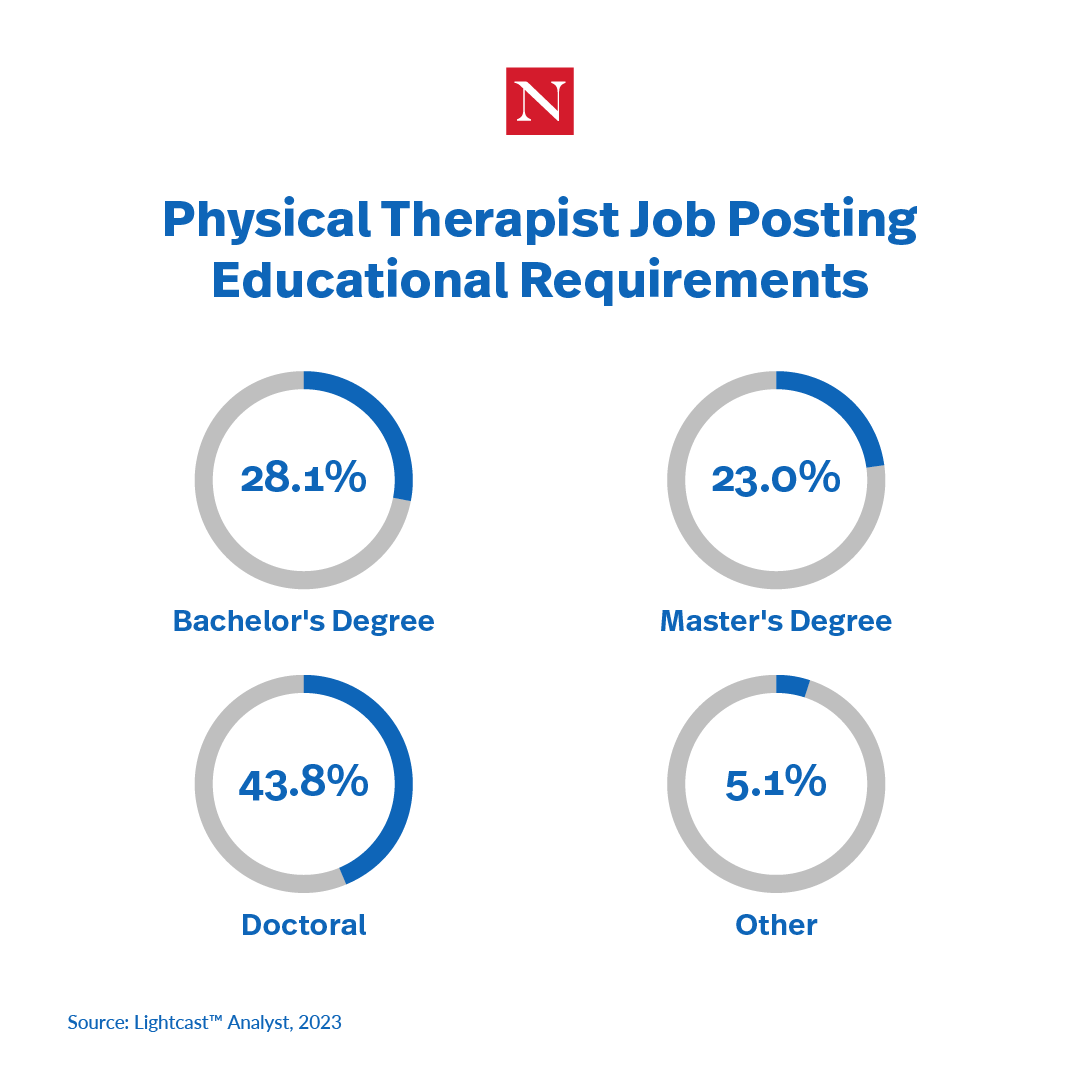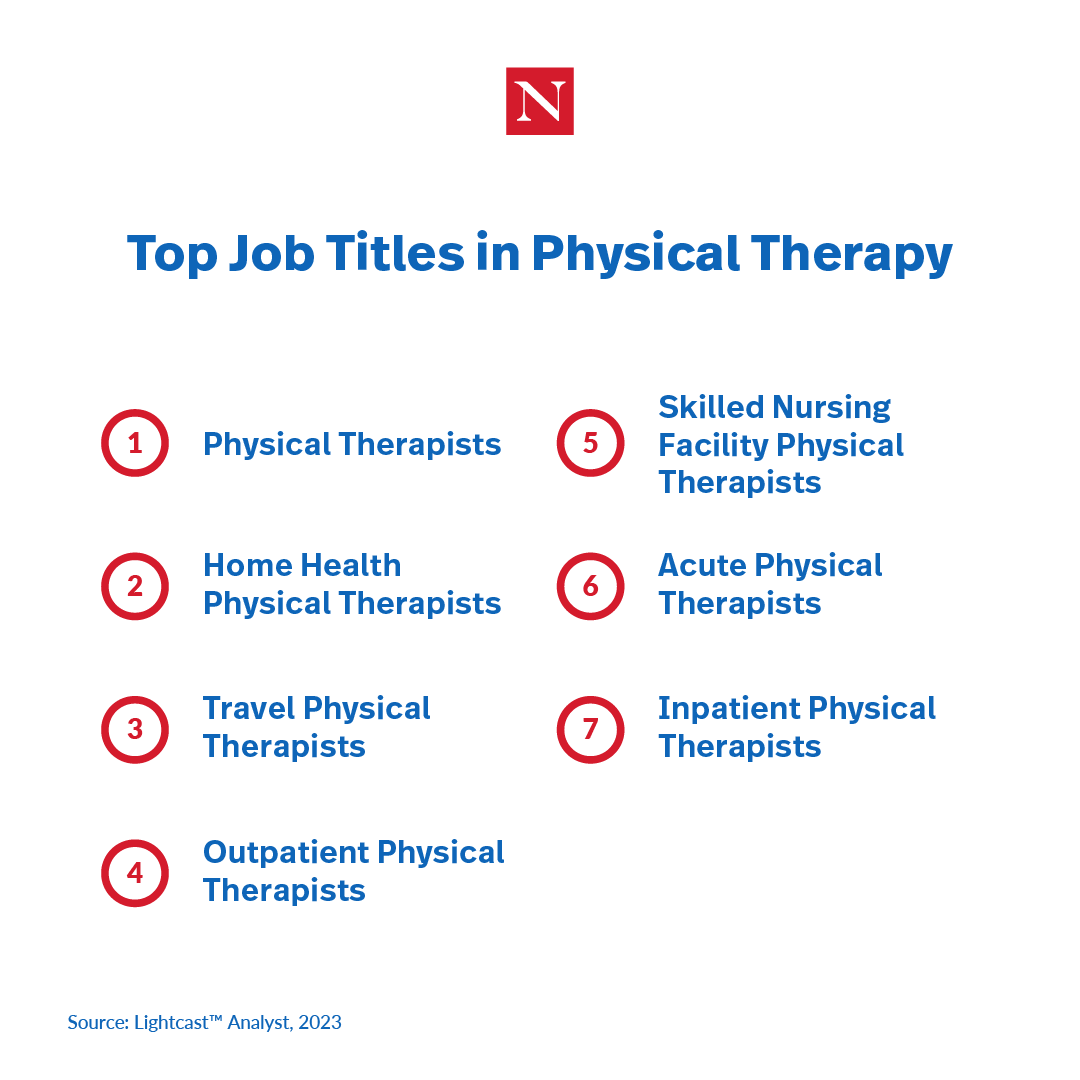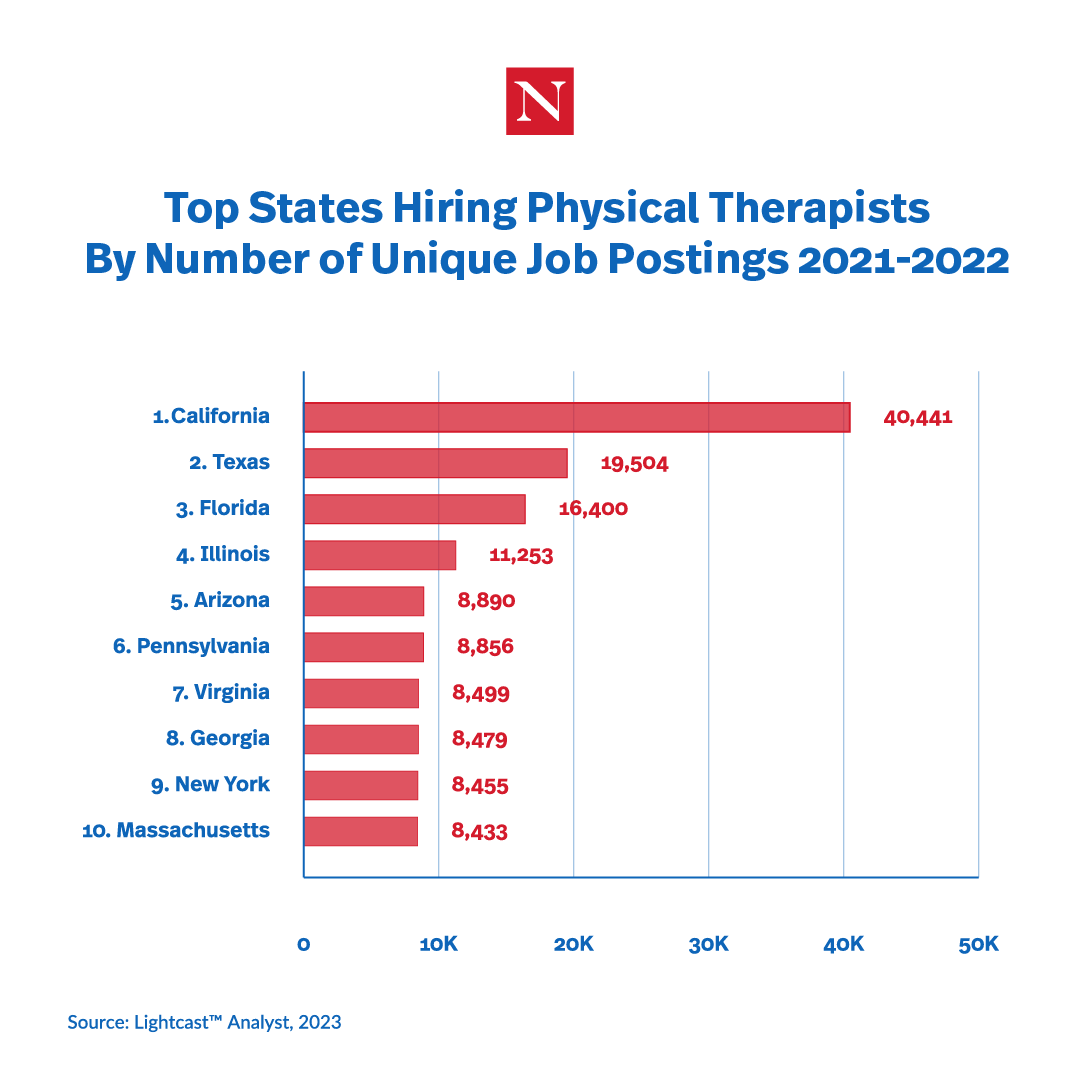While physical therapy is a growing field that has gained new ground in the last decade, there remains a common misconception that there’s only one career path available to prospective therapists. However, data continues to show that this healthcare profession is in high demand—even outside of hospitals and private practices.
In fact, according to Dr. Christopher Cesario, Associate Clinical Professor and Director of Student Affairs for the Doctor of Physical Therapy (DPT) program at Northeastern University’s Bouvé College of Health Sciences, “When you’re pursuing a career in physical therapy, the world is your oyster.”
If you’re wondering whether a career in physical therapy is the right fit for you, here’s an overview of what a physical therapist does, the top career paths in this field, the different industries you can work in as a PT, and how you can choose your future career path.
What Is a Physical Therapist?
Physical therapists (PTs) are healthcare professionals who help patients heal from orthopedic, neurological, and cardiovascular disabilities or injuries through prescribed movement. Their goal is to use their education and clinical experience to enhance people’s quality of life.
Quality patient care is a PT’s number one priority. Using a wide range of exercise physiology resources and tools for rehabilitation, physical therapists practice the belief that “movement is medicine,” says Cesario. Some of the main responsibilities physical therapists are expected to perform on a daily basis include:
- Diagnosing physical impairments: PTs determine patients’ injuries or physical challenges that need treatment.
- Creating treatment plans: PTs consider the diagnosis and medical history of the patient to develop a plan that will help with recovery.
- Providing treatment: PTs take the treatment plan and administer it, tweaking as necessary depending on patient progress.
- Educating patients on self-care: PTs spend significant time teaching insights about the human body and explaining treatment plans.
Today, if you’re interested in becoming a physical therapist, you’re required to obtain a Doctor of Physical Therapy (DPT) degree. While the majority of physical therapists have doctoral degrees, our analysis of professional postings data reveals that only half of current PTs acquired this advanced level of education. This is followed by 28 percent earning a bachelor’s degree and 23 percent with a master’s.

These numbers help illustrate the evolving industry standards that have led to the newly required DPT degree. “As of 2014, there are no more programs producing physical therapists without a doctoral program,” says Cesario. “I think a lot of this data is capturing folks of my generation, or older, when a bachelor’s or master’s was enough. Therefore the doctoral number will only continue to grow as the older generation retires.”
Download Our Free Guide to Physical Therapy
Everything you need to know about becoming a physical therapist
Top 7 Jobs You Can Get in Physical Therapy
There are numerous career opportunities for physical therapists—and this number continues to expand. However, most PT professionals start their career in a “standard” setting. According to Cesario, “The gateway for most people is outpatient orthopedic physical therapy. This path typically deals with patient back pain, sprains, and recovery after surgery.”
While some physical therapists will spend the majority of their career in an outpatient environment, others choose different settings in which to practice. According to our analysis of job postings data, here are the top seven careers physical therapists can pursue.


1. Physical Therapists
Anyone who completes their Doctor of Physical Therapy (DPT) degree and passes the licensure exam can practice as a physical therapist. Whatever the workplace setting, they’ll be able to lean on their education and clinical experience to treat patients through movement therapy. Overall responsibilities include diagnosing physical impairments, creating treatment plans, treating patients, and educating them on self care.
2. Home Health Physical Therapists
Home health physical therapists visit and treat patients where they live. This often happens because these types of patients are homebound and cannot travel to a private practice for treatment. These kinds of PTs travel locally, bringing necessary equipment with them to administer treatment plans on the go.
The most common types of patients that require home health therapy include:
- Elderly
- Disabled individuals
- Victims of life-altering injuries
3. Travel Physical Therapists
Like nurses, there are physical therapists who travel to various locations and fill in at hospitals that need staffing help. Traveling physical therapists only assist facilities on a temporary basis (e.g., several weeks or months). While this offers therapists the opportunities to travel throughout the year, this type of career requires an immense amount of flexibility and a willingness to live in various settings around the country. As a result, these positions often pay well and offer living stipends for those willing to relocate on a regular basis.
4. Outpatient Physical Therapists
As Cesario notes, most PTs enter the field having experienced outpatient physical therapy. These physical therapists work with patients who received a referral from a doctor as a result of an injury, illness, or surgery. Typically these therapists build and administer a treatment plan to help patients return to a higher quality of life. PTs at outpatient facilities also assist patients dealing with chronic pain and teach them how to self-administer physical therapy exercises at home.
5. Skilled Nursing Facility Physical Therapists
Patients who have undergone surgeries or suffer from serious orthopedic, cardiovascular, or neurological injuries are often sent to short- or long-term nursing facilities for ongoing care. While they no longer need to be in a hospital setting, patients aren’t quite ready to live on their own in these situations. Physical therapists in these facilities provide treatment in designated physical therapy areas or inside patients’ rooms. An example of a patient who might need to work with a physical therapist at a skilled nursing facility is someone recovering from a stroke or joint replacement.
6. Acute Physical Therapists
Physical therapists in the acute care setting focus on the mobility and ability for patients to safely return home. Patients in this setting can have a variety of conditions that require physical therapy and it’s an opportunity to work closely with an entire healthcare team. An example of an acute physical therapist’s specialization is in the rehabilitation of individuals diagnosed with conditions like cancer or after an orthopedic trauma. This gives PTs the ability to dive deeper into a particular type of diagnosis and seek additional training and certification.
7. Inpatient Physical Therapists
Some careers in physical therapy involve working with patients as they recover in a rehabilitation hospital setting. There are a wide variety of reasons for a PT to intervene in these situations, such as helping a patient regain the use of his arms after a stroke. Inpatient physical therapists are expected to work collaboratively with other medical professionals like doctors, nurses, occupational therapists, and physical therapy assistants.
Where Do Physical Therapists Work?
With so many possible career paths, prospective physical therapists have enormous opportunities to forge their own path in the field. However, it’s important to understand the various settings PTs can work in before making such an important career decision. Here’s a closer look at the various places a physical therapist can work.
Top States Hiring PTs
Since this profession is in high demand, there are plenty of physical therapy job openings across the country. In fact, some states like California are in desperate need of great physical therapists across a variety of settings.
According to our analysis of job postings data, these states currently have the most job advertisements for physical therapists:
- California
- Texas
- Florida
- Illinois
- Arizona
- Pennsylvania
- Virginia
- Georgia
- New York
- Massachusetts

While the data doesn’t include these states, Cesario noted that he’s also “seeing students go to Colorado and the Pacific Northwest post-graduation. I think that part of the country will continue to see physical therapy demand because those communities tend to be younger and more active.”
Top Industries
The request for physical therapy in different environments has expanded in recent years. “I think a lot of people don’t realize physical therapists are in certain environments,” says Cesario. “I’m hearing more and more people in the past few years diving into a niche in physical therapy that wasn’t there a decade ago.”
While the types of jobs in physical therapy span industries, according to our analysis of job postings data these are the top five employing PTs:
- Offices of Other Health Practitioners
- General Medical and Surgical Hospitals
- Home Health Care Services
- Offices of Physicians
- Nursing Care Facilities

While these are the top industries that are hiring physical therapists, it’s important to touch on the opportunities emerging for PTs outside of the traditional healthcare industry. Consider the types of physical therapy jobs graduates of Bouvé College of Health Sciences’ Doctor of Physical Therapy (DPT) program obtained. Alumni cite past experiences working with professional basketball teams, equestrians, and even Broadway actors. While these aren’t common, it’s important to understand that these opportunities exist in the field.
Other physical therapists can choose to expand their experience and become entrepreneurs. An excellent example of this is the expanding field of telehealth as a result of the global pandemic. “One of our alumni works in telehealth, using her cardiopulmonary physical therapy skills to virtually treat and prescribe people privately.”
Another Northeastern graduate used their personal passion of powerlifting to carve out another PT career opportunity. “After experiencing some injuries herself, one of our alumni now provides physical therapy services for other female powerlifters,” Cesario continues.
As a result, PTs no longer have to enter the field with a single job title in mind. Instead, they have the opportunity to move fluidly to different settings. “These are all great examples of the possible entrepreneurial piece that can come with physical therapy,” says Cesario. “I think that’s growing in popularity. People who have an entrepreneurial spirit are taking the core of what they’ve learned in healthcare and turning it into a business venture.”

Choose Your Own Career Path
Becoming a physical therapist offers many students the opportunity to choose their own career path. With so many options, it’s a promising profession for anyone looking to make a difference. Whether you would prefer a traditional PT role or you’re intrigued by more entrepreneurial pursuits, choosing the right DPT program is essential to your success.
Bouvé College of Health Sciences’ Post Baccalaureate Doctor of Physical Therapy (DPT) program offers students a holistic approach to education, research, and practical experience. If you’re interested in taking agency in your physical therapy career, consider a DPT program like Bouvé’s that’s already produced numerous physical therapists in unconventional industries. If you’re interested in learning about enrollment options, contact a Northeastern University admissions counselor for more information about their DPT program.







Related Articles
4 Pressing Global Health Problems We Face Today
Global Health Careers: How Can I Make a Difference?
Compliance Specialists: Who They Are and What They Earn